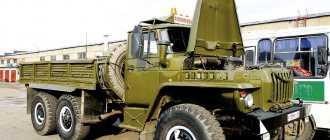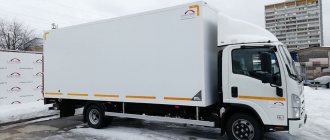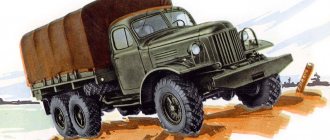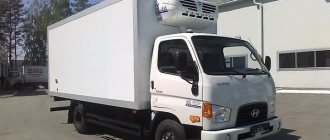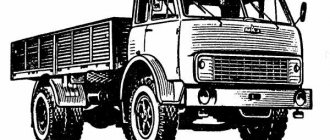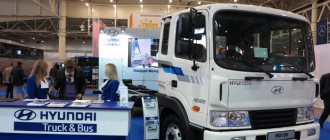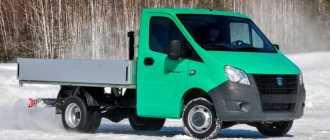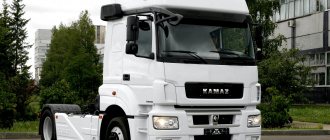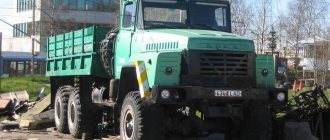The high demand for light-duty vehicles in the early nineties of the last century prompted the plant named after. Likhachev (AMO ZIL) to begin developing this type of machine.
The first design experiments based on the experience of foreign automakers were carried out in 1992-1993.
An increase in car production was observed until the second half of the 2000s, but the emergence of competing models produced by GAZ and Chinese analogues reduced volumes by almost a third by 2008. In 2010, the production of Bychkov was transferred to the Petrovsky division of the plant. The model received the Grand Prix at the Design-95 exhibition.
Grunwald semi-trailer: their features and characteristics (tipper, reviews).
Description and technical characteristics of KamAZ 5320 here.
MAZ 5516 and its technical characteristics.
Equipment ZIL 5301: technical characteristics
The name “Bull” is consistent with the architecture of the car, which includes a large cabin equipped with a short, stubborn hood and stubborn headlights.
The use of a gearbox, hydraulic power steering ZIL 131, as well as brake mechanisms from the Yunost bus made the car the heaviest in its class. The total weight reached 7 tons, and for the first time a hydraulic booster was installed on a three-ton vehicle.
Under the hood of the truck, they first installed a modified diesel tractor engine from Belarus, codenamed MMZ D-245.10 (105 hp), and later MMZ D-245.12S (109 hp) and MMZ D were added to the line of power units -245.9 (136 hp).
In addition, small batches were produced with installed diesel engines from the American corporation Caterpillar, the French Renault and the Bulgarian Vamo. Domestic engines installed on the model are listed in the table. Table 1 - Engines installed on the ZIL 5301 model
| Engine | Power | Optional equipment | Ecology |
| MMZ D - 245.10 | 105 hp | Basic model | — |
| MMZ D - 245.12S | 109 l. With. (80 kW) | Injection pump Motorpal intercooler turbocharger Schwitzer | Euro 1 |
| MMZ D - 245.9 | 136 l. With. | Intercooler turbocharger air pressure regulator | Euro 2 |
All modifications are equipped with a five-speed manual gearbox.
The technical characteristics of the ZIL 5301 Bychok on different versions do not differ significantly. The main parameters for the base model with the MMZ D-245.9 E3 turbocharged power unit, on which an intermediate air cooling system is installed, are described in Table 2.
Technical characteristics of the ZIL 5301 Bychok
| Engine volume, l | 4.75, four-cylinder |
| Power, hp (kW) | 130 (95,7) |
| Speed max, km/h | 95 |
| Torque for standard ZIL 5301 engines, Nkm | 350 |
| Fuel consumption, l/100 km at a speed of 60 km/h | 12 |
| Time to accelerate to 60 km/h, sec | 30 |
| Total weight, kg | 6950 |
| Permissible load for front wheels, kg | 2350 |
| Permissible load for rear wheels, kg | 4900 |
| Load capacity of ZIL 5301, kg | 3450 |
| Turning radius, m | 7,8 |
| Clutch type | Single disk |
| Gearbox type | Mechanical five-speed |
| Drive axle type | Hypoid with one stage |
| Cardan transmission structure | Two shafts, 3-joint design, intermediate support. The shafts are connected via sliding splines. |
| Steering | Hydraulic booster |
| Brakes | Front disc |
| On the rear axle | Drums installed |
| Electrical diagram of ZIL 5301 | Single wire |
| Supply voltage, V | 24 |
| Overall dimensions of the platform, m | 3.75 by 2.25 by 0.45 |
The car is equipped with tubeless tires 225/75R16С and rims measuring 6.5Jx16H2. A spare wheel, a set of keys, a jack, etc. are included in the ZIL 5301 delivery package. The operating instructions provide for running-in of the machine and periodic maintenance. Then 1 is performed after 4,000 kilometers, and then 2 after 16,000 km.
Kamaz 4308 technical characteristics and its description.
The versatile and economical Kamaz 65115 dump truck is here.
On this page you will find a description of the reliable and durable Kamaz 6520 equipment.
Manual ZIL 5301 Bychok 1998 - page 1
ZIL-5301 Bull. INTRODUCTION
Fig.1. Car ZIL-5301
Vehicles of the ZIL-5301 family are designed for transportation of various cargoes on any paved roads, as well as for conversion into specialized vehicles.
The vehicles are designed to be used without a trailer.
The vehicle is manufactured in the “U” version according to GOST 15150 and is designed for operation at ambient temperatures from plus 40 to minus 40 °C, relative air humidity up to 80% at 20 °C, air dust content up to 0.1 g/m3.
More than 35 modifications are produced based on the ZIL-5301 vehicle. Information about the main ones is given below.
Vehicle ZIL-5301 AO (5301-0000014) - with an onboard platform and a base of 3650 mm, designed for transporting goods on paved roads.
Vehicle ZIL-5301DO (5301-0000019) - with an onboard platform and a base of 4250 mm, designed for transporting long and low-density cargo on paved roads.
Automobile chassis ZIL-5301 BO (5301-
0001014) with a base of 3650 mm, intended for retrofitting with a special body or installation.
Automobile chassis ZIL-5301EO (5301-
0001015) with a base of 4250 mm, intended for retrofitting with a special body or installation.
Automotive chassis ZIL-5301GA (5301-0001017) with a wheelbase of 4250 mm, equipped with a four-door, two-row cab and intended for retrofitting with a special body or installation.
Vehicle EIL-5301AA (5301-0000020-02) - with a van body, equipped with an extended cabin with two berths, designed for transporting goods on paved roads.
Vehicle ZIL-5301TO (5301-0000017) with an onboard platform and a wheelbase of 4250 mm, equipped with a four-door, two-row cabin and intended for servicing repair and technological services.
ZIL-5301 Bull. SAFETY REQUIREMENTS AND WARNINGS
1. Proper operation of the vehicle and its durability can only be ensured through careful and regular maintenance in compliance with all the rules set out in this manual.
2. During the first 1000 km of driving, all mechanisms wear out parts, so during this period it is especially important to strictly follow the rules given in the “Operation of a new car” section.
3. It is prohibited to transport vehicle chassis under its own power over a distance of more than 300 km. 4. It is prohibited to start driving when the red indicator lights on the instrument panel are on. 5. The vehicle should be driven after the engine has warmed up until it operates stable in idle mode. Immediately after starting a cold engine, it is impossible to develop a high (more than 1500 rpm) crankshaft speed, especially at negative ambient temperatures. 6. When operating a vehicle, diesel fuel should be used in accordance with GOST 305-82*. During summer operation - fuel grade "L"; at
winter: at temperatures from 0 to minus 30 °C, grade “3” fuel, at temperatures below minus 30 °C - grade “A” fuel.
7. It is not recommended to idle the engine for more than 15 minutes.
8. The duration of continuous operation of the starter should not exceed 15 s.
9. It is forbidden to turn off the engine until the car has completely stopped or when the car is moving on a slope, as this will lead to a sharp increase in the force on the steering wheel and stop the supply of compressed air to the pneumatic brake drive.
10. It is prohibited to set the instrument and starter switch to the “Parking” position while the vehicle is moving, as this may block the steering and the vehicle will become uncontrollable.
11. When working in the engine compartment with the engine running, be careful to avoid possible injury from rotating fan blades and drive belts.
12. It is prohibited to warm up the engine in a closed room with poor ventilation to avoid poisoning from exhaust gases.
13. When opening the expansion tank cap when the engine overheats, you should remember that steam may escape from the neck of the tank, leading to burns to the face and hands.
14. Ethylene glycol low-freezing mixtures are toxic. If they come into contact with the skin, wipe the area dry and wash with warm water and soap.
15. Long-term work on a vehicle with the power steering inoperative is not allowed, as in this case the steering mechanism is overloaded.
16. When leaving a rut or maneuvering, you must not drive for more than 15 seconds with the steering wheel turned to its extreme position and turning force applied to it, since in this case the power steering pump operates at maximum pressure and may fail due to oil overheating.
17. Only clean filtered oil should be used for power steering; add oil through a double mesh funnel. When using contaminated oil, the parts of the pump and power steering quickly wear out.
18. Installation of power take-off boxes on a gearbox for driving special mechanisms is allowed only after agreement with the Department of Design and Experimental Work (UKER) AM O ZIL of the operating mode and procedure for operating the mechanism.
Installation of power take-offs without approval from UKER deprives the consumer of the right to submit complaints to the manufacturer for premature failure of vehicle parts.
19. Do not disconnect the battery while the engine is running to avoid damage to the generator diodes and other semiconductor devices.
20. It is impossible, even for a short time, to connect the battery to the network by connecting the positive terminal of the generator to the negative terminal of the battery.
21. Connect the wires to the generator and voltage regulator in strict accordance with the markings on these products.
22. All work on the repair and replacement of electrical equipment should be carried out only after disconnecting the battery terminals from the vehicle’s electrical network. This needs to be done
and when recharging batteries from an external power source.
23. It is forbidden to disassemble the spring energy accumulator of the parking brake system, since there is a powerful spring in a compressed state in the cylinder. It can only be disassembled in a workshop using a special tool.
24. Care should be taken when handling brake fluid, as it is poisonous.
25. You cannot be under a car that is raised on a jack. The jack should only be installed in the locations specified in these instructions.
26. To avoid fire, do not allow fuel and oil to leak, and also do not use an open flame to warm up the units.
27. When washing a car, do not allow water to enter the air filter to avoid water hammer when starting the engine.
It is not allowed to wash the inside of the cabin with water from a hose or bucket due to the possibility of damaging electrical equipment.
28. It is prohibited to drill, cut, or weaken in any other way the horizontal flanges of the frame side members.
ZIL-5301 Bull. OPERATING A NEW VEHICLE
The service life of the vehicle, as well as the reliability and efficiency of its operation, largely depend on the running-in of parts during the initial period of operation. During this period, more thorough vehicle maintenance and strict adherence to the special operating rules outlined below are necessary.
During the first 2000 km, the vehicle speed should not exceed 60 km/h; load the vehicle more than 75% of the rated load.
In the initial period, special attention should be paid to fastening the steering bipod, steering mechanism, steering rod ball pins, swing arms, king pin wedges, axle shaft flanges, cardan shaft flanges, and spring ladders.
The wheel nuts should be tightened every 100 km until the tightening torque stabilizes (360...440 N.m).
After 1000 km of the vehicle, it is necessary to perform all maintenance operations outlined in the Maintenance section for the first 1000 km.
Chronic diseases ZIL 5301. Owner reviews
There are no ideal cars, but preventing “diseases” allows you to operate the vehicle for a long time, especially when it comes to commercial vehicles.
This statement is confirmed by reviews published online. ZIL Bychok 5301 has a number of disadvantages, some of which are related to the human factor, and some to technical problems inherent in the domestic automobile industry. First of all, it should be noted that the paintwork of the cabin does not stand up to criticism. Already during the first month of operation, you can observe paint peeling off the hood of a ZIL 5301 truck. Photos of short-term used vehicles offered for sale on automobile portals are indisputable proof of this fact. You can judge the most common problems in more detail by studying multiple reviews.
If the owner purchased autonomous heating for an additional fee, then attention should be paid to the durability of the system and the lack of a separate warranty for the unit. As for the cabin, the hatch built into the roof is quite convenient, but in most cases it leaks.
In winter, vehicle owners report difficulty starting. This problem can only be solved by carefully preparing the fuel and starting systems. In addition, there are problems in dismantling the cooling radiator and the complexity of the process of replacing the air filter.
When operating a vehicle with overload, the tires of the wheels tear, but the load on the engine is not felt.
It is not recommended to skimp on the quality of fuels and lubricants during operation. In addition to the engine and transmission, it is necessary to periodically service the rear axle. ZIL 5301 is a model that is the most expensive to maintain among all models of the car plant. It is recommended to change the engine oil every 10,000 km, and replace it in the box after 30,000 km. The rear axle with gearbox from the 130th model has a number of problems:
- cracking of crosspieces;
- coloring satellites;
- differential gear defects.
Improper maintenance of the elements of the rear drive axle leads to the replacement of the entire ZIL 5301 unit. Video materials showing the results of vehicle operation confirm the serial breakdown. Owners and maintenance personnel are recommended to carry out maintenance taking into account faults identified by many years of experience, and not use the saying that a good knock will come out on its own. Usually, the occurrence of breakdowns “pulls” others with them and the cost of maintenance and repairs increases significantly.
